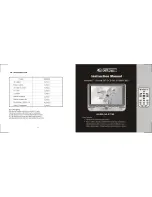
4.11. Output port:
There are two output ports on the front panel of the instrument, users must not input signal to the output
port as a possibility of damaging the instrument.
4.11.1. Signal output port:
*
【
Output
】:
the signals that the instrument generates are all output from the signal output port, press
【
Output
】
key to open or close the signal from the output port circularly.
*
The output port is open when the “Output” light is on, and close when the “Output” is off. If wrongly
connect external high voltage to signal output port, instrument will suffer “inverse filling” danger, and then
instrument will turn on the protection function, close immediately signal output port and make an alarm
with the “Output”light off. In this case, you must check external load, only after eliminating the failure can
press
【
output
】
key to open signal output port.
4.11.2. Sync output port
《
Sync
》
:
Output pulse wave compatible with TTL and CMOS, high level >4 V, low level <0,3 V.
1.)
Under single frequency function, sync signal is a square signal with TTL level, the frequency of sync
signal is the same as the frequency of the signal from
《
Output
》
port, when the phase is set to be
0
,
the phase of sync signal is the same as the phase of the signal from the
《
Output
》
port.
When the phase is set to be 1
,
the phase of sync signal is the opposite of the phase of the signal
from the
【
Output
】
port.
2.)
Under frequency sweep function, the sync signal is a pulse signal with TTL level, the rising edge of
the pulse wave match along with the start point of the sweep, and the falling edge of the pulse wave
match along with the middle point of sweep range, the period of pulse wave is the same as sweep
time.
3.)
In FM, AM, PM, PWM modulation, sync signal is a square wave with 50% duty cycle, whose
frequency equals to frequency of modulating waveform and phase refers to the phase of modulating
waveform.
4.)
In FSK, sync signal is a square wave with 50% duty cycle, whose frequency equals to hop rate, when
outputting carrier frequency, sync signal is low level; when outputting hop frequency, sync signal is
high level.
5.)
When pulse string output, sync signal is a pulse wave whose rising edge corresponds to start point,
falling edge corresponds to stop point, and cycle equals to pulse string repeated cycle.
6.)
In frequency sweep, pulse string and FSK, if select manual trigger or external trigger, frequency of
sync signal will be determined by trigger signal.
4.12. Input port
There is a trigger input port
【
Trig In
】
on the rear panel of the generator, which could be used only as the
input channel of external signal, but not output channel. This port could be also used as the input channel
of pulse signal which is compatible with TTL and CMOS, the high level of which is higher than 4V, and
low level is lower than 0.3V.
4.13. Programmable interface
There is an USB device interface socket
【
USB Device
】
on the rear panel of the instrument, through
which the instrument could be program-controlled by connecting to computer with an USB cable. The use
method of this interface is described in detail in the CD that attached with the instrument.
-50-







































